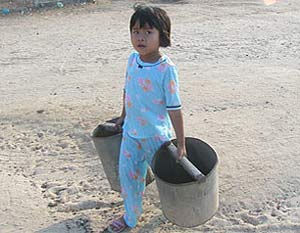Although not yet received official information about El Nino appeared, but the leaders of the agricultural sector in the Central and Central Highlands are very concerned. If El Nino returns, it can increase the area of water shortage, narrow the area of winter-spring paddy and affect food security.

This girl had to replace her mother to queue to buy water in the dry season in 2005. (Photo: PV)
Talking to VnExpess on the afternoon of November 20, Mr. Nguyen Son, Director of Gia Lai Department of Agriculture and Rural Development expressed: " If El Nino appears, it is extremely concerned. Food security may be threatened, starvation occurred, people's life in the province turned upside down .
Gia Lai expects this winter-spring crop to cultivate 20,500 hectares of wet rice. If dryness increases, the province can cut about 3,000-4,000 hectares."However, we still prioritize water for rice production to ensure food security. 70,000 hectares of coffee and 4,000 hectares of pepper will have to accept water shortages, reduce productivity," Son said.
Mr. Son is still not obsessed with the El Nino in 1997-1998, when the vast coffee forest of the province has lost its leaves, the productivity has decreased because the amount of water is only enough to sustain life for coffee, not help. flowering, fruit-bearing plants. In particular, thousands of people in Chu Se, Kon Chro and Krong Pa districts have suffered from lack of drinking water.
Phu Yen is a coastal province in the South Central Coast, although it is a rainy season, but the leaders of the agricultural sector are still anxious to fear that El Nino will return. Deputy Director of the Department of Agriculture Le Chi Trong said that the district and irrigation exploitation companies have directed water storage in reservoirs since last week, nearly one month earlier than every year.
This is the most optimal measure to ensure water for 25,500 ha of winter-spring rice, 20,000 ha of sugarcane, the main source of living of the residents in the province. However, Mr. Trong said, the mountainous districts such as Dong Xuan, Son Hoa and Song Hinh still have to accept the lack of water, because the new irrigation works here are under construction.
El Nino's ability to appear up to 92%
According to the latest announcement of the International Research Institute for Climate Forecasting (IRI), by mid-November, the sea surface temperature in the equatorial Pacific region was 1 degree C higher than normal, exceeding 1.5 degrees Celsius in the center and away from the eastern equator of the Pacific.Predicting the probability of IRI on El Nino in 3 months (December 2006 and 1-2/2007) up to 92%.
Previously, at the end of October, the agency forecasted the possibility of El Nino appearing at 80%.
(Source: Center for Climate and Meteorological Research)
Occupying the highest cultivated area of winter-spring rice in the South Central region (48,000 ha), Binh Dinh is also worried about not enough water for rice cultivation. During the rainy season, the water volume of the lakes is very low, approximately 30% of the designed capacity.
Vo Thanh Tien, Director of the Department of Agriculture said: "Calculating 48,000 ha of winter-spring rice is in the condition of favorable rain and wind. If El Nino is forced, it will be cut a few thousand hectares". The province has instructed districts to increase water retention, to distribute water economically and to switch to drought-resistant plants in areas at risk of water shortage.
Seeing the possibility of water shortage, at the end of October, at the conference on production of winter-spring crop 2006-2007 held in Binh Dinh, Department of Water Resources, Ministry of Agriculture and Rural Development directed the South Central provinces to accumulate. water in reservoirs, dredging canals right after flood season. The southernmost part of Central Vietnam, including Phu Yen and Ninh Thuan, must prepare facilities to transfer daily-life water to people when there is no local water source.
For the Central Highlands provinces, the Department of Water Resources instructs to save water for irrigation of coffee trees during the flowering period, not to let the spontaneous people grow too capable of water resources. In the winter-spring crop of 2006-2007, it is expected that South Central Coast will cultivate 178,000 hectares of rice and Central Highlands cultivated 59,905 hectares of rice.
Hong Khanh

 Is the magnetic North Pole shift dangerous to humanity?
Is the magnetic North Pole shift dangerous to humanity? Washington legalizes the recycling of human bodies into fertilizer
Washington legalizes the recycling of human bodies into fertilizer Lightning stone - the mysterious guest
Lightning stone - the mysterious guest Stunned by the mysterious sunset, strange appearance
Stunned by the mysterious sunset, strange appearance